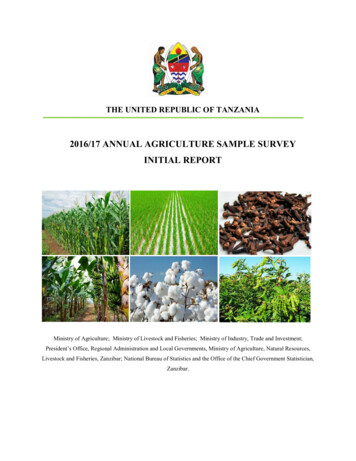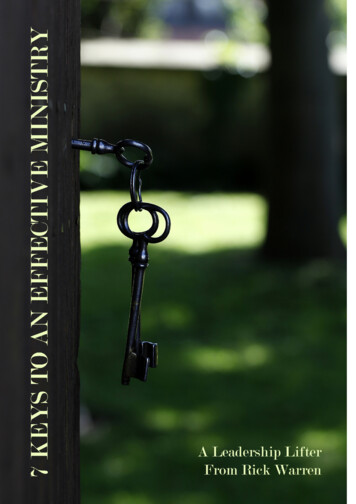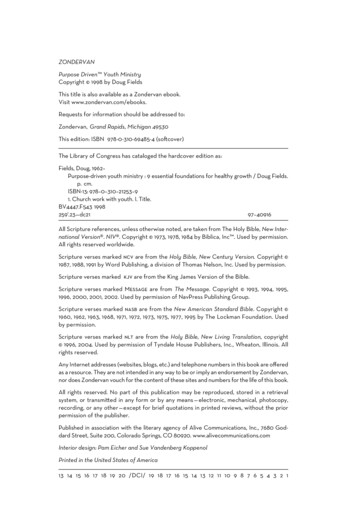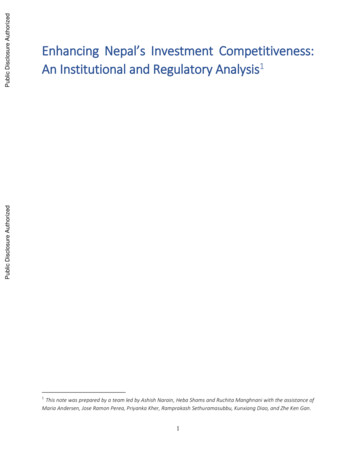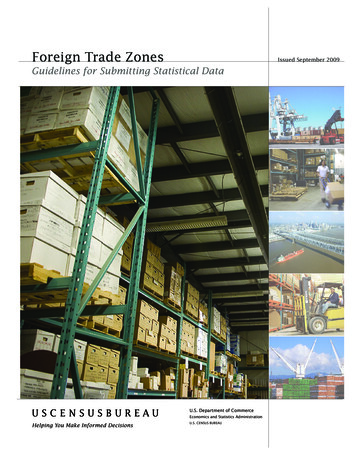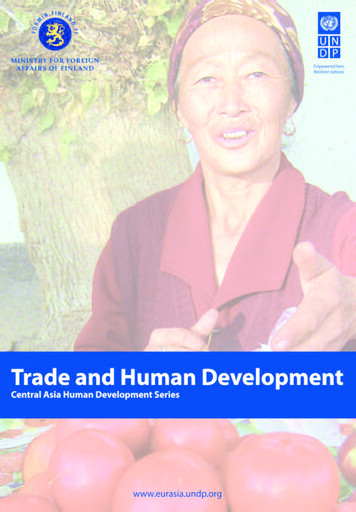
Transcription
C E N T R A L A S I A T R A D E A N D H U M A N D E V E L O P M E N T PA P E RMINISTRY FOR FOREIGNAFFAIRS OF FINLANDEmpowered lives.Resilient nations. 2014 by the United Nations Development Programme Regional Bureau for Europe and the Commonwealth of Independent StatesISBN 978-92-95092-78-5All rights reserved. No parts of this publication may be reproduced, stored in a retrieval system ortransmitted, in all forms by any means, mechanical, photocopying, recording or otherwise prior permission.Cover design: Bekhzod MakhkamovPhoto: Copyright @ UNDP AfT projectEditing: Ben SlayLayout and printing: Valeur s.r.o., Slovak RepublicWork on this paper was financed by UNDP’s regional Aid for Trade project, with support from the Government of Finland’s Wider Europe InitiativeThe views expressed in this publication are those of the author(s) and do not necessarily representthose of the United Nations, including UNDP, or their Member States.2w w w.eurasia.undp.org
C E N T R A L A S I A T R A D E A N D H U M A N D E V E L O P M E N T PA P E RAcknowledgementsInitial drafts of this paper were prepared by Dr. Richard Pomfret, Professor of Economicsat the University of Adelaide since 1992. Subsequent editorial work was done by BenSlay, Poverty Reduction Practice Leader of UNDP Regional Center.Helpful comments on earlier drafts were provided by Virginia Cram-Martos, Director ofthe Trade and Sustainable Land Management Division of UNECE; Elena Danilova-Cross,Human Development Policy Analyst of UNDP Regional Centre; Jonathan Hall, Head ofUnit of the National Human Development Reports; Jan Harfst, Chief of UNDP RegionalBureau for Europe and CIS; Kamolkhon Inomkhodjayev, Programme Associate of UNDPUzbekistan; Boyan Konstantinov, Programme Specialist of UNDP Regional Center; MalikaKoyanbayeva, Programme Analyst of UNDP Kazakhstan; Sheila Marnie, Economist ofUNDP Central Asia sub-regional office; Philip Peirce, Development Consultant at UNDP;Joern Rieken, Trade policy specialist and Aid for Trade Team Leader at UNDP RegionalCenter; Massimiliano Riva of UNDP Bureau of Development Policies; Mubin Rustamov,Programme Analyst of UNDP Tajikistan; Pradeep Sharma, Deputy Resident Representativeof UNDP Kyrgyzstan; Mika Vepsalainen, Chief of Trade Policy and Government Cooperation Section of UNECE and Larissa Zelenina, Deputy Head of Coordinated Macroeconomic Policy Section of Eurasian Economic Commission.Paper layout, printing and translation were supervised by Elena Danilova-Cross.AbstractBy increasing GDP and creating new income- and employment-generation opportunities–particularly for vulnerable communities–international trade can promote humandevelopment. Both trade theories and national experience point to potential pro-pooroutcomes for low- and middle-income countries that specialize in the production andexport of labour-intensive goods and services. UNDP’s 2005 Central Asia Human Development Report therefore called for a more pro-active approach to trade (and transportand transit) in the region. In light of new developments and trends now unfolding inthe region–concerning global and regional integration, migration and remittances, andthe unbundling of global value chains–this paper builds on UNDP’s 2005 report by updating the case for policies and programming that can help global and regional integration promote human development in Central Asia.w w w.eurasia.undp.org3
C E N T R A L A S I A T R A D E A N D H U M A N D E V E L O P M E N T PA P E RTable of contentsAcknowledgements. . . . . . . . . . . . . . . . . . . . . . . . . . . . . . . . . . . . . . . . . . . . . . . . . . . . . . . . . . . . . . . . . 3Abstract. . . . . . . . . . . . . . . . . . . . . . . . . . . . . . . . . . . . . . . . . . . . . . . . . . . . . . . . . . . . . . . . . . . . . . . . . . . . . 4List of boxes, charts, and tables . . . . . . . . . . . . . . . . . . . . . . . . . . . . . . . . . . . . . . . . . . . . . . . . . . . . . . 6Foreword(s) . . . . . . . . . . . . . . . . . . . . . . . . . . . . . . . . . . . . . . . . . . . . . . . . . . . . . . . . . . . . . . . . . . . . . . . . . 71. Executive summary . . . . . . . . . . . . . . . . . . . . . . . . . . . . . . . . . . . . . . . . . . . . . . . . . . . . . . . . . . . . . . . 92. Trade issues move toward the centre of Central Asia’s development agenda . . . . . . 113. Trade liberalization, WTO accession, and human development . . . . . . . . . . . . . . . . . . . 254. Value chains and transport corridors . . . . . . . . . . . . . . . . . . . . . . . . . . . . . . . . . . . . . . . . . . . . . 375. Eurasian integration . . . . . . . . . . . . . . . . . . . . . . . . . . . . . . . . . . . . . . . . . . . . . . . . . . . . . . . . . . . . . 436. Migration, remittances, and human development. . . . . . . . . . . . . . . . . . . . . . . . . . . . . . . . 517. Conclusions . . . . . . . . . . . . . . . . . . . . . . . . . . . . . . . . . . . . . . . . . . . . . . . . . . . . . . . . . . . . . . . . . . . . . 578. References. . . . . . . . . . . . . . . . . . . . . . . . . . . . . . . . . . . . . . . . . . . . . . . . . . . . . . . . . . . . . . . . . . . . . . . 61Annex I–Trade, human development, and the Millennium Development Goals . . . . . 72Annex II–Human development indicators in Central Asia . . . . . . . . . . . . . . . . . . . . . . . . . . . 73w w w.eurasia.undp.org5
C E N T R A L A S I A T R A D E A N D H U M A N D E V E L O P M E N T PA P E RList of boxes, charts, figures, and tablesBoxesBox 1. The Dordoi bazaar and clothing exports in the Kyrgyz Republic . . . . . . . . . . . . . . 29Box 2. Border management in Central Asia . . . . . . . . . . . . . . . . . . . . . . . . . . . . . . . . . . . . . . . . . 41Box 3. The Eurasian Economic Commission. . . . . . . . . . . . . . . . . . . . . . . . . . . . . . . . . . . . . . . . . 43ChartsChart 1. Central Asia’s concentrated commodity composition of exports (2012). . . . . 11Chart 2. Merchandise export growth rates (2000-2012) . . . . . . . . . . . . . . . . . . . . . . . . . . . . . 12Chart 3. World price trends (historical data). . . . . . . . . . . . . . . . . . . . . . . . . . . . . . . . . . . . . . . . . 15Chart 4. World price trends (historical data and projections) . . . . . . . . . . . . . . . . . . . . . . . . 15Chart 5. Merchandise trade balances in Central Asia (2000-2012) . . . . . . . . . . . . . . . . . . . 15Chart 6. Trends in Central Asian trade turnover with Russia, China. . . . . . . . . . . . . . . . . . . 16Chart 7. Numbers of international arrivals (2011) . . . . . . . . . . . . . . . . . . . . . . . . . . . . . . . . . . . 34Chart 8. Kyrgyz Republic: Shares of tourism in GDP (2008-2012). . . . . . . . . . . . . . . . . . . . . 35Chart 9. Kyrgyz Republic: International tourist arrivals by source country (2012) . . . . . 35Chart 10. Ratios of remittance inflows to GDP (2012) . . . . . . . . . . . . . . . . . . . . . . . . . . . . . . . 52Chart 11. Kyrgyz Republic: Ratios of remittance inflows to GDP (2010-2012). . . . . . . . . 52Chart 12. Kyrgyz Republic: Income poverty rates with, without remittances . . . . . . . . . 52FiguresFigure 1. International trade and human development . . . . . . . . . . . . . . . . . . . . . . . . . . . . . 20TablesTable 1. Shares of GDP, employment represented by agricultural activities . . . . . . . . . . 13Table 2. Shares of GDP, employment represented by wholesale, retail trade . . . . . . . . . 13Table 3. Shares of GDP, employment represented by tourism . . . . . . . . . . . . . . . . . . . . . . . 14Table 4. Landlocked country rankings from the “trading across borders”category of the World Bank’s Doing Business survey (June 2013) . . . . . . . . . . . . 14Table 5. Central Asian countries’ development indicators . . . . . . . . . . . . . . . . . . . . . . . . . . . 22Table 6. Central Asian and neighbouring countries’ WTO status . . . . . . . . . . . . . . . . . . . . 31Table 7. Tourism in Central Asia. . . . . . . . . . . . . . . . . . . . . . . . . . . . . . . . . . . . . . . . . . . . . . . . . . . . . 33Table 8. Development and external competitiveness indicatorsin selected EurAsEC countries. . . . . . . . . . . . . . . . . . . . . . . . . . . . . . . . . . . . . . . . . . . . . . 48Table 9. Gender and the labour market in the Kyrgyz Republic. . . . . . . . . . . . . . . . . . . . . . 546w w w.eurasia.undp.org
C E N T R A L A S I A T R A D E A N D H U M A N D E V E L O P M E N T PA P E RForeword(s)UNDP’s 2005 Central Asia Human Development Report described the many benefits–for people, as well as for states and economies–that deeper cooperation in theregion could bring. It also proposed concrete initiatives, policies, and programming directions in which governments, businesses, civil society, and the international communitycould work together to create “borders with a human face”. Increased cooperation ontrade and transit, as well as on water and energy management, disaster preparedness,and other issues, were explored–both for the region and for its neighbours.Developments in the subsequent decade have been mixed: more and better cooperation in some areas has been accompanied by less progress in others. Global andregional economic integration are among the areas in which important changes haveoccurred in the last ten years. In contrast to 2005, the vast majority of Central Asia’strade today falls under policy frameworks that are compatible with the principles ofthe World Trade Organization. Thanks to the Eurasian integration project, many obstaclesto the free movement of goods, services, and people along Kazakhstan’s northernborder with the Russian Federation have disappeared. Large migrant labour flows fromCentral Asia’s low- and lower middle-income countries to the Russian Federation haveled to the deep integration of these countries’ labour markets. They also generatebillions of dollars in remittances annually, which are essential to the external balanceof Tajikistan and the Kyrgyz Republic, as well as provide critical support to vulnerablehouseholds across the southern parts of the region. Billions of dollars of foreign investment from China, the Russian Federation, and elsewhere have co-financed governmentinvestment programmes to upgrade the region’s transport infrastructure and developits extractive sectors.While much research has been devoted to the economics, political economy, financeand sectoral dynamics of these developments, their human dimensions are often overlooked. While economic growth is lifting many boats in Central Asia, only about half ofthe region is employed, and the numbers of individuals working in “decent jobs” aresmaller still. Although migration and remittances are helping to reduce poverty, theirsocial side effects–for children, families, and communities–may be quite troubling.Moreover, the production of the energy, metals, minerals and cash crops that dominateCentral Asian export baskets often poses significant burdens on the region’s delicateecosystems. Meanwhile, high transit costs (only some of which can be explained by theregion’s landlocked character) continue to impede the export of labour-intensive manufacturing and services (like tourism) that can boost job creation.w w w.eurasia.undp.org7
C E N T R A L A S I A T R A D E A N D H U M A N D E V E L O P M E N T PA P E RWritten with support from the Government of Finland’s Wider Europe Initiative, thispaper investigates the human development side of these questions. It assesses the important poverty, social, and environmental implications of the global and regional integration trends now unfolding in Central Asia, by taking a people-centred approachthat focuses on how integration is affecting (and could affect) the sustainability of theregion’s natural, human, and social capital. UNDP hopes that the ideas and analysescontained in this paper will help policy makers, development professionals, and CentralAsianists to better see the people behind the trade and migration numbers, as well asdevelop the trade and migration policies and programming needed to put people first.Cihan SultanoğluAssistant Administrator andDirector, Regional Bureau for Europe and CIS8w w w.eurasia.undp.org
C E N T R A L A S I A T R A D E A N D H U M A N D E V E L O P M E N T PA P E R1Executivesummary Two decades after independence, the Central Asian economiescontinue to rely on the export of a small number of primaryproducts. Except for Kazakhstan, growth in merchandise exports from the Central Asian countries during the past decadehas been below the rates reported by many developing andtransition economies. At- and behind-the-border barriers to trade in Central Asia remainsignificant. This is apparent in the World Bank’s Doing Businesssurveys, which rank the Central Asian countries at the very bottom of its “trading across borders” category. Higher trade costsare a particular burden for small and medium-sized enterprisesin such labour-intensive sectors as agriculture, light industry,wholesale and retail trade, and tourism. High trading costs andlow levels of competitiveness and productivity in these sectorsconstrain employment and limit possibilities for pro-poor growth. Trade and integration issues are moving towards the centreof Central Asia’s development agenda. This is apparent in there-emergence of WTO and Eurasian integration initiatives, thegrowing importance of global value chains, improvementsin the region’s transport infrastructure, and continued growthin already large migration and remittance flows. With the recent accession of the Russian Federation (2012)and Tajikistan (2013) to the World Trade Organization (WTO),the vast bulk of Central Asia’s trade now occurs with WTOmember states. The experience of the Kyrgyz Republic (whichhas been a WTO member since 1998) shows that WTO mem-w w w.eurasia.undp.org9
C E N T R A L A S I A T R A D E A N D H U M A N D E V E L O P M E N T PA P E Rbership and the relatively open trade regimes that it promotescan bring important human development benefits. But it alsoshows that WTO membership is not by itself a game-changer.10 The Customs Union created in 2010 by the Eurasian EconomicCommunity is seeking to both deepen into an economic unionby 2015, and widen by including the Kyrgyz Republic and(possibly later) Tajikistan. Eurasian integration could boostCentral Asia’s human development prospects–particularly ifit goes beyond preferential trading relations to address questions of institutional development, formalizing migration andremittance flows, and boosting the competitiveness of labourintensive export-oriented sectors. But if the Customs Unioncreates more barriers to trade between members and nonmembers, and if it hinders Central Asia’s inclusion into globalvalue chains, then the region could miss out on importantdevelopment opportunities. The emergence of global value chains as drivers of economicgrowth affords Central Asia important development opportunities–particularly in light of the region’s proximity to threeBRICS countries (Russia, India and China). However, taking advantage of these opportunities requires renewed nationalcommitments and regional cooperation to improve CentralAsia’s transport infrastructure and remove other at- and behind-the-border trade barriers. These developments are creating new opportunities for diversifying Central Asian export baskets, and expanding trade,production, and employment in labour-intensive sectors. Lessreliance on commodity exports could also reduce the burdenson the region’s environmental, human, and social capital. Lowskilled workers, women, small-scale producers and traders,and residents of border communities could particularly benefitfrom these human development opportunities.w w w.eurasia.undp.org
C E N T R A L A S I A T R A D E A N D H U M A N D E V E L O P M E N T PA P E R Activities to take advantage of these opportunities could include: reductions in at- and behind-the-border barriers to trade,particularly via trade facilitation and border managementinitiatives; investments in the competitiveness and productivity ofthe small-scale producers and traders who have not fullshares thus far in the benefits of economic integration inCentral Asia; and assurance that efforts to facilitate WTO and Eurasian integration reflect the human development needs of, and opportunities for the Central Asian countries.w w w.eurasia.undp.org11
C E N T R A L A S I A T R A D E A N D H U M A N D E V E L O P M E N T PA P E R2Trade issues move towardthe centre of Central Asia’sdevelopment agendaAt independence, the five Central Asian countries1 were openeconomies, exporting a small number of primary products. This characteristic has changed little in the two subsequent decades (Chart 1).Energy, cotton, and metals and minerals account for about 90% ofmerchandise exports from Kazakhstan, Tajikistan, and Turkmenistan.While Uzbekistan and the Kyrgyz Republic show more diversified export baskets, metals and minerals (gold), energy (gas, coal), and primaryagricultural products (cotton) account for about two thirds of merchandise exports from these countries. Light industrial and machineryproduction account for about one quarter of these countries exports.Chart 1: Central Asia’s concentrated commodity composition of exports (2012)100%Other80%Petrochemicals60%Light industry40%Other farm products20%MachineryUNDP calculations, based onInternational Trade Center(ITC) yzKazakhstan0%Metals and mineralsEnergyHigher exports of these primary products have boosted growth inGDP, output, and incomes in Central Asia–especially during the globalcommodity price boom that took hold in the middle of the last decade,Kazakhstan, the Kyrgyz Republic, Tajikistan, Turkmenistan, and Uzbekistan.12Cottonw w w.eurasia.undp.org
C E N T R A L A S I A T R A D E A N D H U M A N D E V E L O P M E N T PA P E Rand peaked around 2011. However, with the exception of Kazakhstan,growth in merchandise exports from the Central Asian countries duringthe past decade has generally been below the rates reported by comparable developing and transition economies (Chart 2).Because production in most of Central Asia’s export sectors isbased on capital-intensive production technologies, export growthdoes not necessarily translate into commensurate employmentgrowth. Together with demographic trends (large numbers ofyoung people entering the workforce each year) and governancechallenges in the public and private sectors, these structural characteristics depress job growth in the region. Decent employmentopportunities are therefore a key development challenge in CentralAsia–especially for its low- and lower middle-income countries.2Chart 2: Merchandise export growth rates, annual averages (2000-2012)24%22% 21%19% 19% 18% 18% 18%17%15% 15% 14% 14% 14%13% 12%AzerbaijanQKa atza arkhstanChM inaongoGe liaorgiaIndiaLibyBe alaruTu srkeyRussAr iamenUk iaraM ineolUz dovbe akKy istargyz nRTa epTu jiki .rk stamen nistan5% 3%Efforts to promote trade–particularly in labour-intensive sectorsthat can create employment- and income-generation opportunitiesfor vulnerable workers–could help address these challenges in CentralAsia. The data shown in Tables 1, 2, and 3 indicate that export growthcould mean new development opportunities in agriculture, light industry, tourism, and wholesale and retail trade. These are sectors thatproduce tradable goods and services, and in which women and vulnerable groups (e.g., the urban poor, vulnerable rural households) tendto be over-represented in the labour force.2UNDP calculations, based ondata from the UN StatisticalDivision’s annual trade totalsdata base.For more on the global decent work agenda, see kagenda/lang--en/index.htm.w w w.eurasia.undp.org13
C E N T R A L A S I A T R A D E A N D H U M A N D E V E L O P M E N T PA P E RTable 1: Shares of agricultural activities in:CountryUNDP calculations, basedon 2012 data from nationalstatistical office websites.* Includes hunting, fishing,forestry, and related services.Nominal yz Rep.17%30%30%Tajikistan23%66%*.Table 2: Shares of wholesale, retail trade activities in:CountryUNDP calculations, basedon 2012 data from nationalstatistical office websites.Nominal yz Rep.16%15%18%Tajikistan15%6%n.a.Table 3: Shares of tourism activities in:CountryUNDP calculations, based on2012 data from nationalstatistical office web sites.* 2011 data.Nominal Kyrgyz Rep.4,7%4,5%7,2%Tajikistan0,4%0,3%.However, using trade to promote labour-intensive growth inCentral Asia has not always been a priority. Instead, as UNDP’s 2005Central Asia Human Development Report pointed out, most ofthe Central Asian governments have been slow to adopt measuresto lower trading costs (which can be especially harmful for landlocked economies3) and boost the productivity and competitiveness of small-scale producers and traders. The report also providedexamples of how high trade costs, which prevented diversificationaway from resource exports, were restricting pro-poor growth. TheWorld Bank’s Doing Business surveys, which rank the Central Asiancountries at the bottom of its “trading across borders” category3The problems of “landlockedness” in Central Asia have been analysed by Raballand (2003), Grafe, Raiser, andSakatsume (2005), Cadot, Carrère, and Grigoriou (2006), and Grigoriou (2007).14w w w.eurasia.undp.org
C E N T R A L A S I A T R A D E A N D H U M A N D E V E L O P M E N T PA P E RTable 4: Landlocked country rankings from the “trading acrossborders” category4 of the World Bank’s Doing Business survey(June 2013).CountryRankingFormer Yugoslav Rep. of Macedonia 88Serbia102Armenia116Bosnia and ay154Bhutan172Nepal177Mongolia181Kyrgyz Out of 189 countries,total. Turkmenistanwas not s.(Table 4), underscore the continued presence and importance ofthese barriers. While the higher trading costs faced by landlockedcountries are reflected in this ranking, the Central Asian countriescompare poorly even vis-à-vis other landlocked economies.On the other hand, a number of trends suggest that issues oftrade, economic integration, and regional cooperation are movingtowards the centre of the development agenda in Central Asia.These include the following:4These rankings reflect data collected in response to survey questions concerning the numbers of documentsrequired to conduct export and import transactions, the time required to complete these transactions, andthe costs of exporting and importing a freight container.w w w.eurasia.undp.org15
C E N T R A L A S I A T R A D E A N D H U M A N D E V E L O P M E N T PA P E RHas the commodity price boom peaked? The run-up in globalcommodity prices that began just before the turn of the century(Chart 3) gave an important boost to Central Asian exports. Thiswas particularly the case for energy exporters Kazakhstan and Turkmenistan, but also for Uzbekistan. On the other hand, in additionto limiting progress in economic diversification and heighteningDutch disease concerns, the boom widened gaps between theregion’s energy exporting middle-income countries and low-income, oil/gas importing Tajikistan and the Kyrgyz Republic–whichtypically report large trade deficits (Chart 5). These low-incomecountries were also hit by soaring food prices during this time.Chart 3: World price trends (historicaldata, 1999 100)600120Metals500Energy400CottonChart 4: World price trends (historicaldata and projections,* 2011 1000)10080Food* Projections begin in 2013.UNDP calculations, based onInternational MonetaryFund (IMF) primarycommodity 620072008200920102011300Since 2011, global commodity prices have moderated. TheIMF projects falling commodity prices during 2013-2018 – particularly for cotton, but also for energy (Chart 4). If these forecastsare correct, then the Central Asian countries that have benefittedmost from the run-up in global commodity prices will face adverse terms-of-trade movements during the next five years.Russia resurges, and China emerges. The past decade hasseen the economic resurgence of the Russian Federation, whichhas likewise enjoyed an energy-led boom. The Russian Federation’s merchandise trade turnover with the Central Asian countriesrose five-fold (from 6.2 billion to 31.9 billion) during 2000-2012(Chart 6). Legal entities registered in the Russian Federation re-16w w w.eurasia.undp.org
C E N T R A L A S I A T R A D E A N D H U M A N D E V E L O P M E N T PA P E RChart 5: Merchandise trade balances in Central Asia (vis-à-vis GDP, 2000-2012)30%20%10%0%2000 2001 2002 2003 2004 2005 2006 2007 2008 2009 2010 2011 an-50%Tajikistan-60%Kyrgyz Republicported some 5 billion in foreign direct investment flows intoCentral Asia during 2005-2012. Perhaps most importantly for vulnerable households in Central Asia, annual remittance flows fromthe Russian Federation to the region (as measured by moneytransfer flows monitored by the Central Bank of Russia) rose fromvirtually nil in 2000 to 11.6 billion in 2012.5UNDP calculations, based onIMF-WEO data and the UNStatistical Division’s annualtrade totals data base.Chart 6: Trends in Central Asia trade turnover* with Russia, China (2001-2012, in billions) 40Uzbekistan 30TurkmenistanTajikistan 20Kyrgyzstan 10Kazakhstan 0RussiaChina2001RussiaChina2012Russia’s re-emergence been matched by the rapid rise inChina’s importance as a trading partner, investor, and financer ofinfrastructure projects in the region. After a decade of rapid5* Merchandise exports plusimports, in dollar terms.UNDP calculations, basedon International TradeCentre data.UNDP calculations, based on ITC and Central Bank of Russia data.w w w.eurasia.undp.org17
C E N T R A L A S I A T R A D E A N D H U M A N D E V E L O P M E N T PA P E Rgrowth, Chinese trade with Central Asia has grown to levels commensurated with the region’s trade with the Russian Federation(Chart 6). In terms of trade flows, there are obvious complementarities between Chinese manufactured exports and Central Asiancomparative advantage in the primary products that China imports. Chinese state-owned enterprises and banks have financedlarge investments in the extraction and transport of key energyand mineral products, as well as high-profile infrastructure projectsin Tajikistan and the Kyrgyz Republic. During his September 2013tour, Chinese President Xi Jinping visited four Central Asian countries, met all five Central Asian presidents, and pledged over 50billion in Chinese funding for energy and infrastructure projects.WTO accession is back on the agenda. Prior to 2013, the Kyrgyz Republic was the only Central Asian country to have joinedthe WTO; of its neighbours, only China was a WTO member. However, the accession of the Russian Federation (in 2012) and Tajikistan (in 2013) changed the region’s WTO dynamics: most of Central Asia’s trade now occurs with WTO member states. Kazakhstan’slong-standing WTO membership aspirations may therefore betaking on new significance; Uzbekistan’s interest in WTO accessionlikewise seems to have quickened.In addition to strengthening the Central Asian countries’ abilities to respond to protectionist measures, WTO membership canhelp boost growth in exports, production, and employment–particularly in labour-intensive light industrial sectors (also inmetallurgy). This is apparent in the Kyrgyz Republic’s experience,in which a relatively liberal trade regime has supported the emergence of an entrepôt trade sector that provides employment fortens of thousands of low-skilled workers, many of them women.WTO membership has also promoted the emergence of a competitive clothing export sector (in which women are likewisestrongly represented) in the Kyrgyz Republic. Expanded exportsof tourism services could be next–particularly in light of therecent liberalization of the Kyrgyz Republic’s visa regime.On the other hand, the Kyrgyz Republic’s export basket continues to be dominated by a single mineral–gold which generateslittle employment, creates negative environmental externalities,18w w w.eurasia.undp.org
C E N T R A L A S I A T R A D E A N D H U M A N D E V E L O P M E N T PA P E Rand is a source of political friction at home and abroad. The informality associated with large bazaars that are the basis for thesetrade and clothing exports also raises questions about their sustainability. In these and other ways, the Kyrgyz Republic’s experienceshows that WTO membership is not by itself a game changer fordevelopment and modernization. Moreover, the WTO’s trade-related intellectual property regulations could reduce access to imported and generic medicines in the region.Eurasian integration gathers speed. The regathering of Russia’s economic weight has made possible the establishment ofthe Customs Union and the Single Economic Space of theEurasian Economic Community (EurAsEC), between Kazakhstan,the Russian Federation, and Belarus. The Eurasian Economic Union(EEU), which would feature the free movement of goods, services,labour, and capital, is to be created in 2015. In addition to pursingan ambitious “deepening” agenda, the “widening” of the Eurasianintegration project may also be in the cards: the Kyrgyz Republicis currently negotiating for Customs Union membership.If the Eurasian integration project remains open to trade withthe rest of the world, if it expands to include the Kyrgyz Republic(and possibly later Tajikistan), if it facilitates the expansion of labourint
trade facilitation), can promote pro-poor trade-led growth, by reducing the trade costs that can be particularly onerous for small and medium-sized enterprises. Aid-for-trade initiatives that address high trade costs and boost the productivity and com - petitiveness of small prod





